There are all these articles about people ‘surviving’, ‘cheating death’ or ‘defying’ the ‘terrifying’ Bolivia Death Road. Along with that ominous nickname, it sounds like cycling the North Yungas Road is really hairy business… or is it? So for all of you out there frantically googling and wondering whether you should try this on your travels in Bolivia, I thought I’d share my personal experience and what you can expect from cycling Bolivia’s Death Road.
Spoiler alert: no one died while I cycled the Death Road, so I offer less sensational tales and more practical advice in this article
My cycling experience
To give some context to this account and decide whether you can relate, know that I’m not a serious cyclist at all. I’m just a fairly active person who doesn’t own a bicycle at home but can cycle decently, and wanted to do something cool on my travels.
I’ve had some serious epic travel moments on a bicycle, like that time I cycled across a sea and 5 islands on the Shimanami Kaido in Japan, but most of the time I cycle to explore outdoor spaces like Chishang in Taitung, or even to get around a city like Taipei. I like cycling well enough but it’s not something I do regularly nor do I arrange special cycling trips when I travel – this is probably the most extreme cycling that I have done.
How did the Death Road get its name?
The Death Road or Camino de la Muerte is officially known as the North Yungas Road, and was named the World’s Most Dangerous Road by the Inter-American Development Bank in 1995 because of the thousands of people who died every year on the Death Road – it was estimated at 200-300 people a month!

Built in the 1930s during the Chaco War by Paraguayan Prisoners of War, this narrow winding mountain road was the only connection between the northern parts of Bolivia and its capital La Paz back then, so many had no choice but to brave this mountain pass despite how many lives it claimed.
Thankfully, a new, wider and more modern North Yungas road that took 20 years to build was finally completed in 2006, and most of the traffic has been diverted that way. The original Death Road still gets a few curious cars passing through, but most of the people on its road today are thrill-seeking cyclists like myself looking to tick off that bucket list item.
Choosing the right company
I had a hostel buddy C who was keen to cycle the Death Road as well, and we were both a bit nervous about picking our cycling tour operator. There are plenty of people trying to get you on their tours in La Paz, but we’ve both read enough of those Death-Defying Death Road articles in our research, so we decided it was worth paying a bit more for reputable names in the business.
If you’ve had good experiences with other companies, feel free to recommend in the comments below for others, but I’m only going to talk about those that I considered:
Gravity Assisted Mountain Biking is the top choice given that their owner was the man who started the tours almost 20 years ago, but they are also the most expensive option in the market at BOB 850 per pax (S$168). We did give them serious consideration because of their great customer service and stellar ratings, but ultimately we went with our other option, equally reputable but cheaper option Barracuda Biking.
Barracuda Biking cost me BOB 570 (S$117) and might still be considered higher priced than some of the other tours out there that are offering tours at BOB 300-400, but our guide and overall service was excellent, safety concerns were high and both bikes and gear were all in good condition, so I’m happy to pay a little more to be on the safe side.
Make sure you have travel insurance and that it covers mountain biking. Barracuda actually asks for your insurance policy details when you sign up, which I think is a good sign of a reputable company who knows what it’s doing.
Do note that you need to factor in the cost of tolls to use the Death Road, which is an additional BOB 50 (S$10) – this will be collected on your cycling route at Unduavi.
The journey begins
La Cumbre Pass @ 4,700m
La Cumbre is about an hour’s drive from La Paz way, way up high in the mountains so you can go on a continuous downhill trajectory. Prepare yourself for the altitude – I’d suggest giving yourself some time to acclimatise in La Paz before you book this tour because you do not want to be suffering altitude sickness on your bike ride.
We had tried the gear and picked our sizes when we did our booking – helmet, gloves, jacket and pants that had pockets and were pretty waterproof – all this was distributed to us in the bus on the way up. I had a bag with extra jackets and stuff that I left on the bus when I was cycling, and my phone was in my pocket but I never took it out while actually cycling, only when I stopped for a break.

You get a chance to test and practice riding your bikes in this little gravel area, as well as get the safety briefing. What’s also interesting is the ritual that Bolivians practice where they drink and pour a little alcohol on the road and bike wheel as an offering to Pachamama. A warning that this is straight up nasty-tasting alcohol so just take a small sip.
Whether or not you believe in Bolivian higher deities, I suggest participating in this ritual in good faith because that’s part of the local culture and I’d rather not risk offending both deities and actual human Bolivianos, and I think you should take all the blessings you can get on this ride.
A smooth start on tarmac
We had 10 legs in total to cycle, and the first two were on this very well paved winding stretch. I actually thought this was a very enjoyable bit to ride because the roads were very smooth, and it is a nice warm-up for you to get comfortable on the bike before the actual gravel track you get later on.
We could stop to take pictures along the way, and pause for breathers as well. There was a tunnel portion where no one was allowed to cycle through, as well as an uphill stretch where we happily jumped back onto the bus for because no one wanted to tire themselves out just yet.
Practice how to use your brakes and regulate your speed along this stretch, and learn which hand is holding on to your back brake and use that often, because if you jam your front brake, you are going to fly over your handlebars.
The actual non-paved Death Road
Now we’re talking about serious business – the group stopped for another briefing and to gear up for the really scary section where we would be cycling along narrow gravel paths with no safety barriers in sight, and sharp hairpin turns with no idea what lay around the corner. Our guide was very experienced and he could tell us exactly what obstacles to expect and how to counteract them so we wouldn’t get freaked out by unexpected things along the way.
The roads are indeed very narrow for vehicles, but it’s actually quite a comfortable width for skinny bicycles. There’s a particular local rule here where cyclists going downhill have to keep to the left side of the road – which is actually the side close to the sheer edge – and let cars coming up pass on the inside. It sounds crazy and counter-intuitive, but it really is less scary than you would think. The important thing is to go at a pace that you are comfortable with and you have good control over the bicycle.
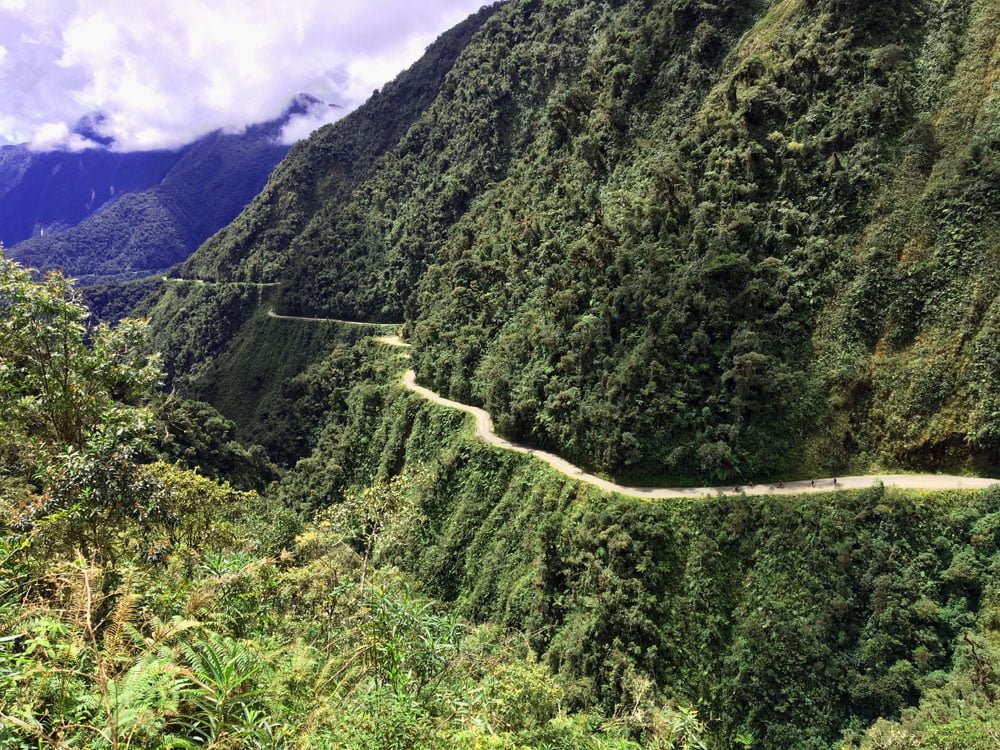
We cycled in single file and kept a reasonable distance from the person in front of us for safety reasons. Any overtaking involved calling out first so as not to freak anyone out by suddenly appearing next to them. If any cars came along in either direction, the easiest way was for cyclists to either slow down or stop along the side of the road and let the car pass before continuing the journey.

The journey ends
Coroico @ 1,200m
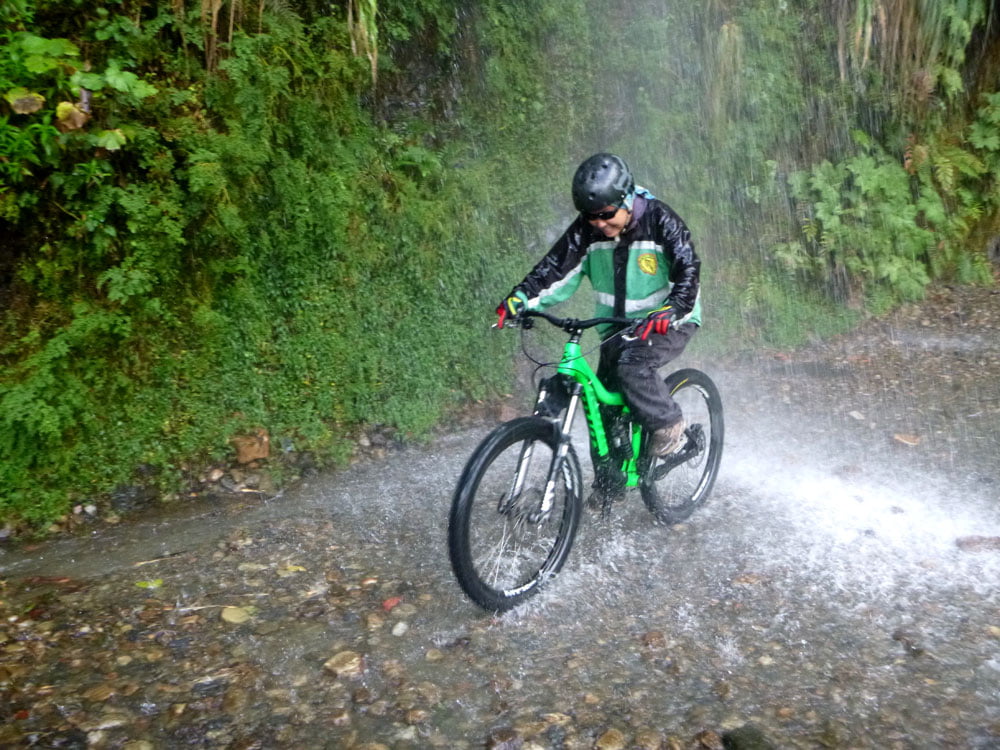
It’s more or less downhill all the way, but there’s a little stretch where you have to do some pedalling on a relatively flat surface at the end. We finally reached the last pitstop, which involved having to cycle through a mini river of sorts which is a bit tricky – if you don’t want to get too wet, hop on the bus at the 2nd last leg.
Our final stop was a little guest house of sorts with a pool and an eating area where we could get lunch and buy some beer (yay!). We could shower as well, a really nice feeling after such a long morning of cycling even if the water was kinda cold.
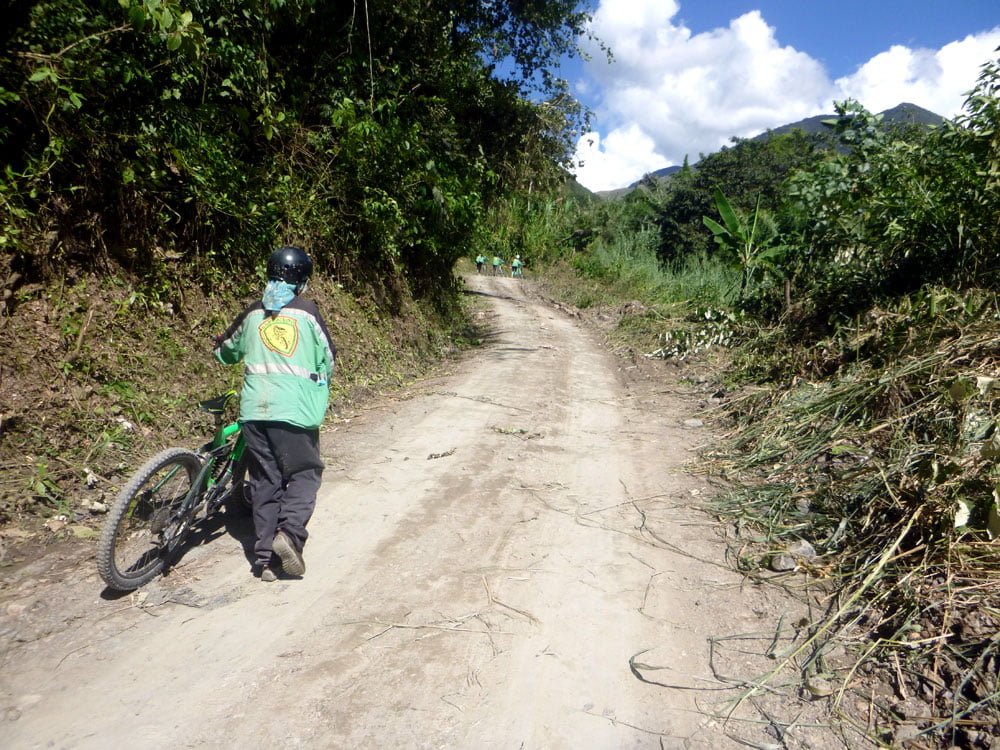
After an afternoon resting and frolicking in the pool, the return trip brought us back up the same hill that we spent most of the day cycling down. It was starting to get dark so there wasn’t any traffic or bikes left on the slope thankfully, and I had to pull on all my jackets again as we headed back up into the mountains and back to La Paz.
So how dangerous is the Bolivia Death Road, really?
Yes, there are risks involved, but if you listen to instructions and don’t do anything stupid, I think you’ll be likely to have a good experience, not taking into account any freak accidents of course.
Know your limits and respect them – what I liked was that you are encouraged to take your time even if the group is all moving quite fast. I was usually one of the slower ones riding near the back of the group because I was a bit more cautious. If any part makes you particularly nervous, you get tired or you run into any trouble, you can hop on and off the bus at any time.

You’ll notice I don’t have any pix or videos while moving because I didn’t have the right gear and mounts. Also, I didn’t want to be that idiot who fell off a cliff because I lost concentration fumbling with the phone in my hands.
Our guide G was very experienced and had lots of stories about mishaps, including one about how he helped to set up for a guy who tried and failed to base jump off the side while cycling (he was pretty injured but lived, thankfully we only watched this video after everything).
That’s not to say you can’t get hurt – my group turned out fine, and while I did see people fall off their bikes, sometimes because they hit an unexpected rock and skidded or lost control, but thankfully there were no major injuries, mostly bruised pride.
We did see an ambulance go by us at one point, so someone else must have gotten hurt at some juncture. There are plenty of stories out there of other people who have fallen, gotten freaked out or witnessed others get hurt or die, so I’d say the risk is definitely there as with any adventure sport. But if you follow instructions closely, err on the side of caution and are not foolhardy, you should be fine.
Do you need to be an expert cyclist?
You don’t have to be an expert cyclist but you should be able to cycle normal paths without losing control of the bike. I think you also do need to be confident in your skills not only so you can tackle the roads, but so you can actually enjoy yourself along the way because it’s no fun if you are completely high-strung the entire time, or end up watching other people whizz by you while you sit on the bus.
If you can’t even handle cycling in a park or a pavement on a relatively flat surface, I’d say give the Death Road a miss and don’t stress yourself out by trying to overstretch your limits.
It also helps if you are relatively fit because that downhill journey takes about 4-5 hours on average including the breaks, the roads are bumpy and you’ll be death-gripping your brakes quite a lot at the beginning, and it does get tiring after a bit.

In the end, I made it and even got the T-shirt to commemorate this event. I’m really glad I gave cycling the Death Road a go – it was challenging for sure, but not as deathly harrowing as its name or the sensationalist articles make it out to be.
Have you cycled the Death Road in Bolivia or are you planning to? Tell me about it here.
Looking for inspiration to travel around South America? Check out my exploration of Colombia and Ecuador, and why not consider learning a little Spanish while you are at it?


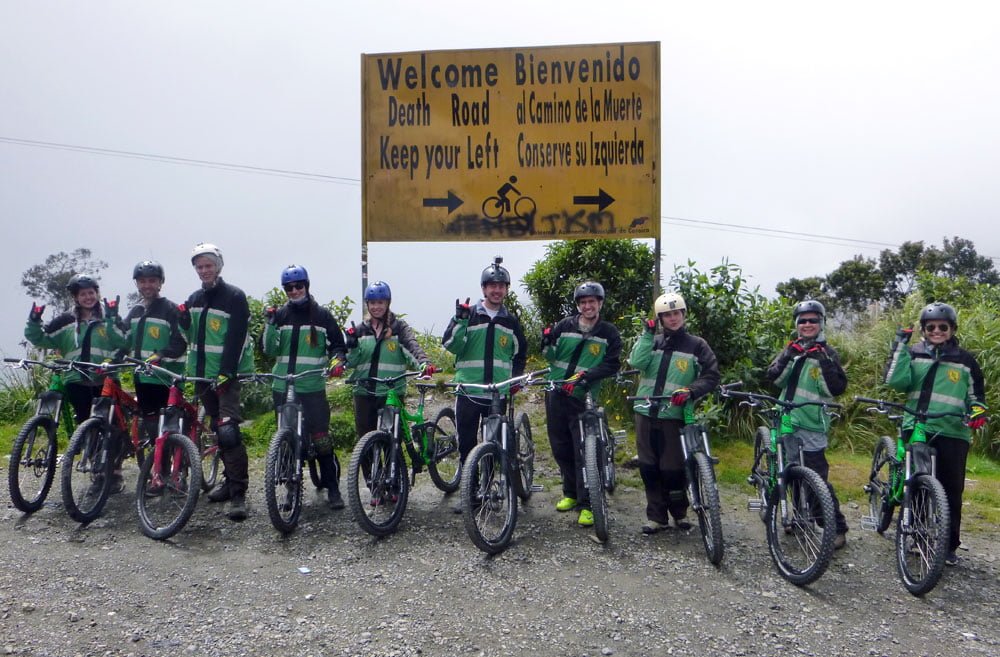

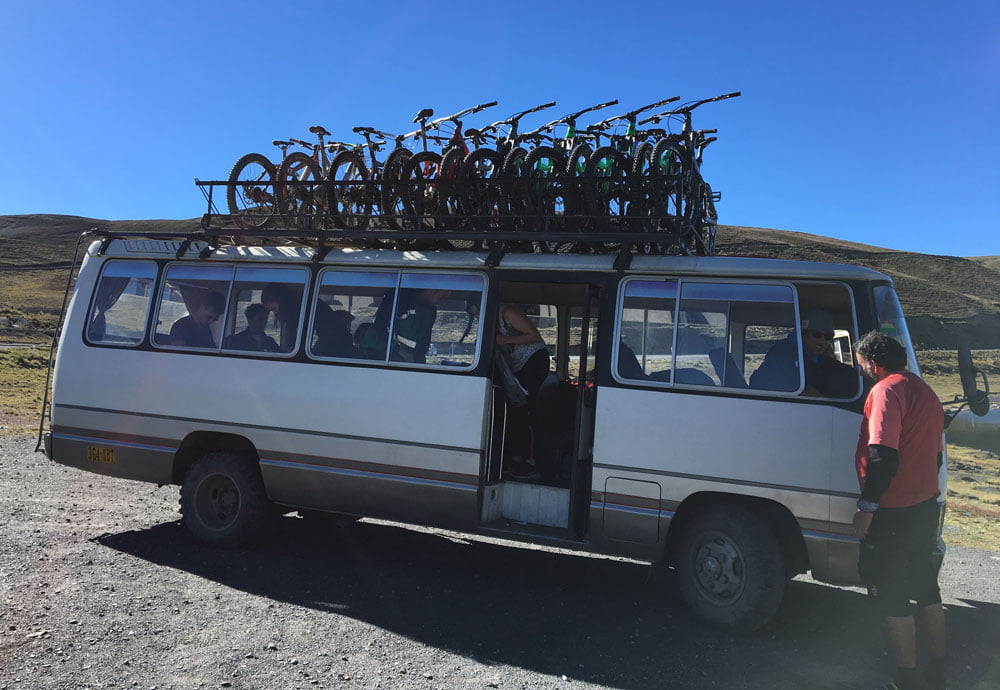




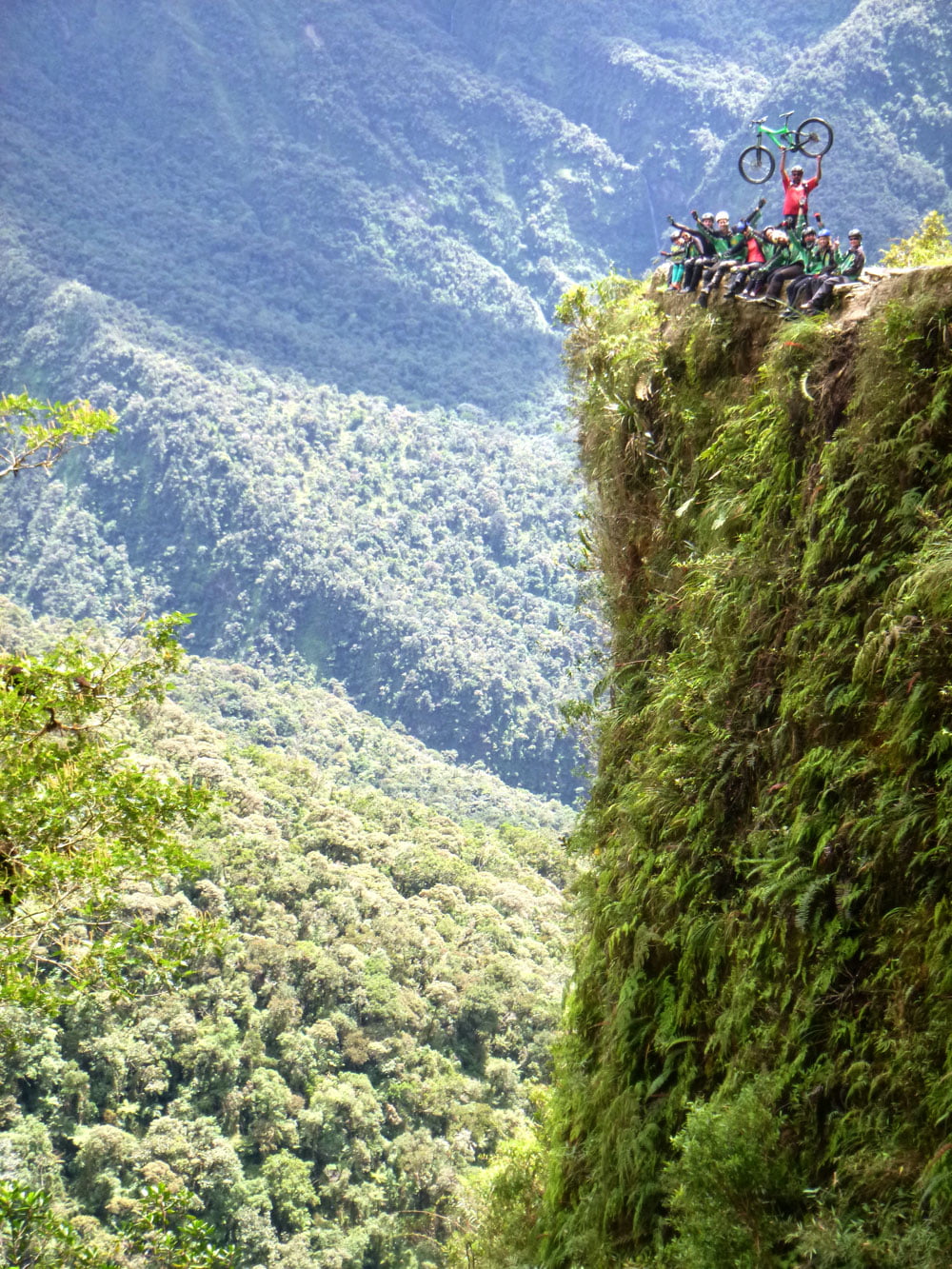
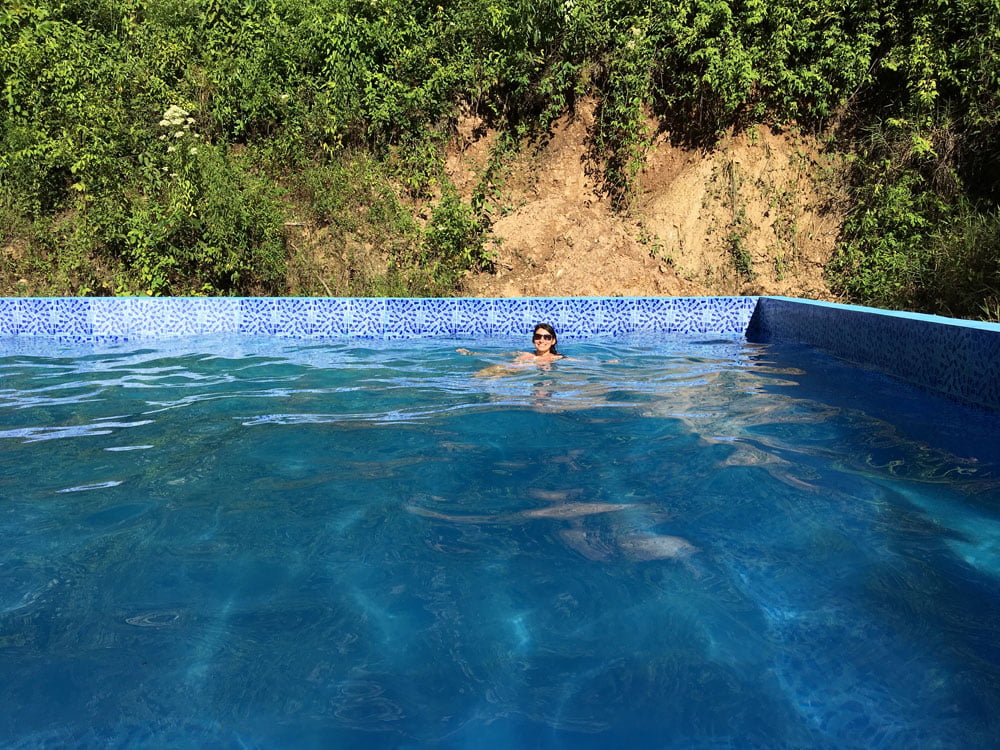


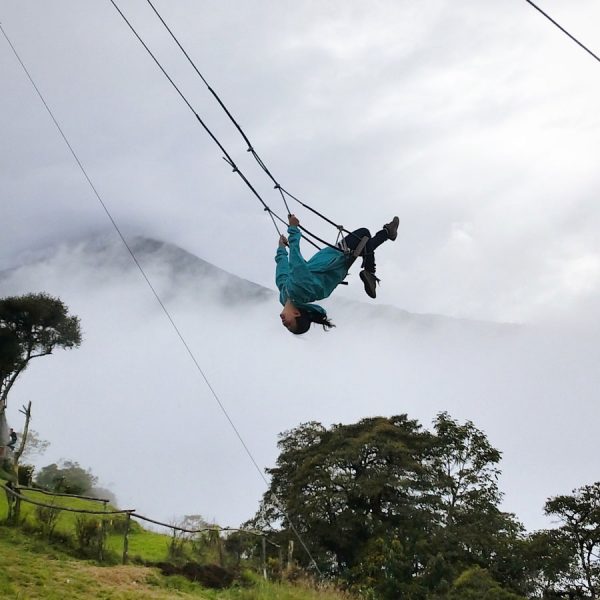

smcumming
Wednesday 9th of October 2019
This is great! We took Barracuda as well. They are a great company. The road is not as dangerous as people think, but you do need to know your limits. We had a girl crash pretty hard on our trip. It is a matter of knowing your limits.
Jaclynn Seah
Wednesday 9th of October 2019
I agree that you do need to manage your own safety and know your own limits! There's ultimately only so much the safest company can do for you if you choose to be reckless... hope you had a great ride :)
Teja
Sunday 21st of January 2018
Eh... that still looks semi-terrifying to me! I met a traveller in San Pedro who insisted that I simply *have* to drive this road, for the amazing views which makes it all worthwhile. But... based on other stuff he's tried on his travels, I'm pretty sure we have significantly different risk tolerance. LOL awesome journey though!
Jaclynn Seah
Sunday 21st of January 2018
If you're up for something challenging and can cycle it's definitely worth doing, but yeah while I'm all for pushing your boundaries, I'd definitely give this good consideration if neither of those two things are what you want :) Thanks for reading!
I think I was a lot more nervous before the trip because I think I had in my head that cartoonish idea of being on a super precarious narrow path, but when you're actually there it's not as bad as what I imagined :P
Karen
Saturday 20th of January 2018
Wow, what a fab read. I've just walked the Caminito del Rey and thought I was brave - although tgat pales into insignificance to your feat. Well done you. Kx
Jaclynn Seah
Saturday 20th of January 2018
heh well walking any sort of long distance thing is something I'd never do, so I guess being brave is also a matter of perspective! :) Thanks for reading and I bet you'll have even more exciting travels up ahead.